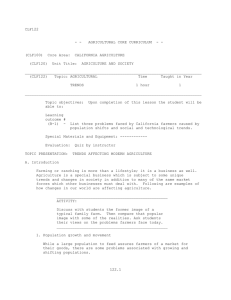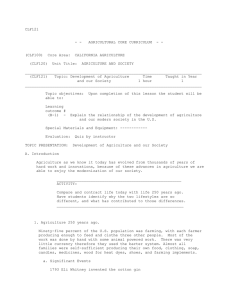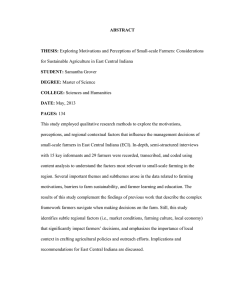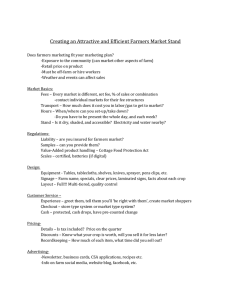Irish Agriculture under Free Trade - A Promising Future?
advertisement
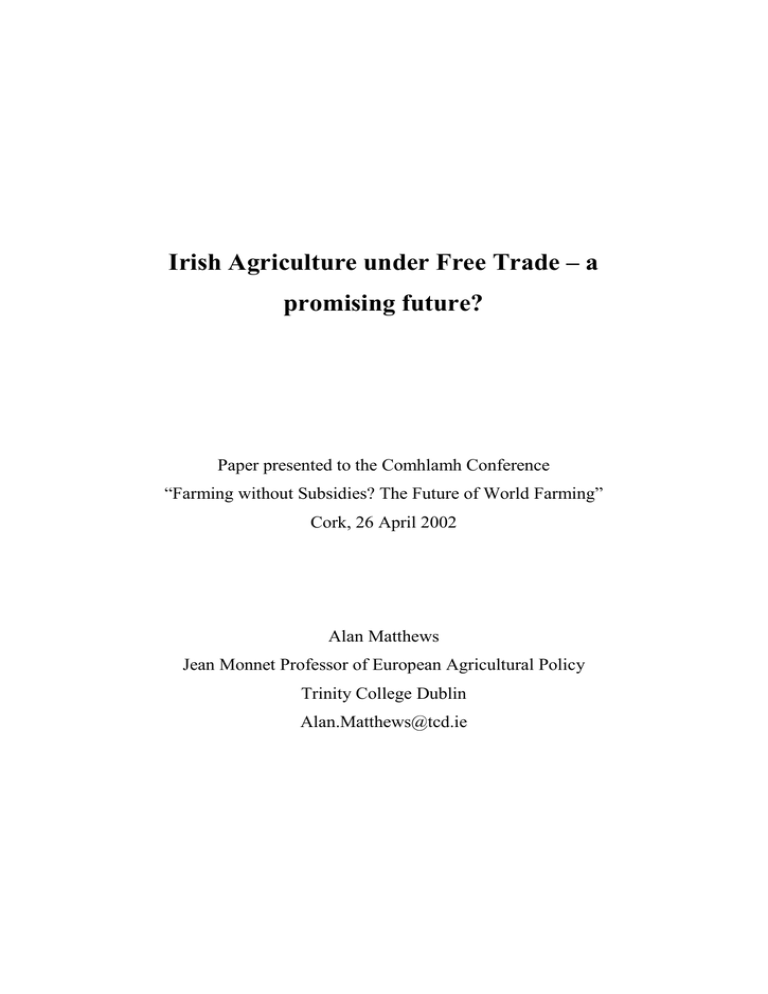
Irish Agriculture under Free Trade – a promising future? Paper presented to the Comhlamh Conference “Farming without Subsidies? The Future of World Farming” Cork, 26 April 2002 Alan Matthews Jean Monnet Professor of European Agricultural Policy Trinity College Dublin Alan.Matthews@tcd.ie Agriculture has changed, agricultural policy must change Irish agricultural policy today is on the road to nowhere. It is damaging farming, it is damaging the non-farm economy and it is damaging the poor in developing countries. It offers no vision of the future, it offers no realistic perspective to younger farmers, it is hugely costly to consumers and taxpayers, it represents a massive waste of resources which could be used much more productively to improve rural society and the rural environment Agriculture has changed, agricultural policy must change to respond to the changing structure of farming and to the changes in society’s priorities. To understand this need for change, we must first look at how agricultural policy has evolved. Farming, the production of food and raw materials from the land, was the predominant activity in subsistence societies and still accounts for up to half the labour force in many low-income countries today. But as economic growth and development takes place, society’s wants and preferences diversify away from food. Non-food expenditure assumes a greater and greater importance. At the same time, productivity growth in food production allows the demand for food to be satisfied with a smaller and smaller labour force. Thus, the importance of agriculture declines with economic growth, as does the absolute number of those engaged in farming. This transformation process is not an easy one. Farming numbers fall mainly because the number of new entrants is smaller than the number of those who leave the sector through retirement or death. Thus farmers tend to be older than the population at large, to have lower levels of education and, as a result, to have lower incomes. Combined with concerns in some countries about ensuring food self-sufficiency and in others with the impact of the fall in agricultural numbers on the viability of rural societies, the perception of a low income problem in agriculture led to substantial government intervention in all European countries in the post-war period. This intervention was intended to transfer income from the increasingly prosperous urban areas to agricultural communities suffering from low living standards, poor housing and poor social amenities. In Ireland, this policy of agricultural support dates back to the 1960s. 1 The mechanism chosen to raise farm incomes was the simple one of increasing the prices which consumers had to pay for their food. In post-war Europe, which was a net food importer, this was easily done by raising tariffs on imported food. Policymakers did not foresee the impact of the scientific and technical revolution in food production due to better knowledge of plant and animal nutrition, the availability of mechanical power and the development of chemical inputs to combat pests and diseases. Combined with the incentive of high prices and guaranteed markets, Europe’s farmers responded and by the mid-1970s structural surpluses of certain products had begun to appear. To stabilise domestic markets, policy-makers resorted to the simple expedient of getting rid of these surpluses on the world market by subsidising their export or, in some cases, simply piling them up in intervention stores. It was an enormously expensive policy, of course, and to control costs production controls were introduced which limited the volume of production farmers could either produce at the supported price or the volume which was eligible for support. Today, all the main Irish farm enterprises are subject to production controls which make further growth in agricultural output virtually impossible. The other main change in farm policy in the 1990s was the substitution, in the case of some commodities (beef, sheepmeat and cereals), of direct payments to farmers in return for some reduction in the artificial support prices. The motivation in the case of cereals was to permit some export at world market prices as well as to increase demand by reducing the cost of an important input for livestock producers. In the case of livestock farmers, direct payments have been used to try to ‘steer’ production practices in a more extensive direction by attaching various types of conditionality including stocking rate restrictions, good farming practice requirements, etc. Counting the cost of agricultural policy The attempt to maintain and defend this agricultural policy is damaging to farmers, to the non-farm economy and to developing countries. Here are some of the reasons why: 2 Farming no longer offers a perspective to a younger generation of farmers who seek to apply their enterprise and skills to building a secure business based on producing goods and services which consumers want. Output levels for all the main enterprises are effectively capped, Irish farmers (and our food industry) are increasingly marginalized in the growing food markets of the world (in Asia, the Middle East and in Latin America) where all the additional demand is being met by our competitors. Europe’s share of world food markets is falling, and must continue to fall as long as current policies are in place. Aggregate farm incomes are now falling and must continue to fall as long as current policies are in place. Direct payments, which currently account for over 50% of farm income and which will account for 70% and more by the middle of this decade, are fixed in nominal terms and are quickly being eroded by Irish rates of inflation which are far higher than in most of the rest of the EU. With 5 per cent annual inflation, the real value of these payments will be halved within 8 years. In the case of our principal farming systems, the value of direct payments now exceeds the actual income the farmer gets from farming activity. Simply giving farmers the payments they currently get and asking them to stop farming would save hundreds of millions of euro per year. We are forcing farmers to produce at a loss in order to qualify for direct payments – a crazy and distorted waste of resources. The need to control overall EU production levels has led to an intrusive and inefficient system of production quotas at farm level. Quotas prevent Irish farmers from producing what they are good at, for example, our best dairy farmers are forced into dual enterprise systems producing beef and dairy which represents an inefficient use of our pasture resource. Quotas also inhibit the entry of younger farmers and the expansion of more enterprising farmers, thus lowering the overall efficiency with which our natural resources are used. The system of quotas and supply controls is undermining the long-term productivity and efficiency of Irish agriculture. There is accumulating evidence that productivity growth in Irish agriculture is slowing down and than over time our ability to compete on world markets is being undermined. 3 Milk yields which were growing steadily until the 1990s have now levelled off, despite still being low in absolute terms compared to those achieved elsewhere. Beef productivity is also falling.1 Total productivity growth which averaged 2.3 per cent per annum in the period between 1984 and 1990 has fallen to less than 1.5 per cent per annum after 1990. Their increasing awareness of Ireland’s loss of competitive advantage, of course, makes farmers more reluctant to produce at world market prices, even though it is the support system which has been put in place which is largely responsible for this failure. The ultimate irony is that a support system intended to support the income of working farmers has the effect of driving up the price of fixed resources such as quota rights and land. Land prices have rocketed in recent years despite stagnant farm incomes. Payments for quota rights mean that the benefit of higher farm prices is passed back to those who are leaving the industry, and do not remain with working farmers. Consumers and taxpayers are hit both coming and going by this system. First, we guarantee to pay farmers between 50 and 100% more than the world market price for our food. This makes food production so attractive that we then have to limit the right to produce food at these very attractive prices. We give away these production rights to farmers who now acquire a very attractive capital asset which they can sell or lease as they see fit. The farm organizations complain about the cost of acquiring quota and the taxpayer is asked to subsidise this cost. The public loses out three times; we rig the market for food in the farmers’ favour in the first instance; we give away the valuable rights to produce food at these artificially high prices; and farmers then ask to be subsidised again so that they can purchase this valuable asset. It is truly an Alice-in-Wonderland scenario. A further way in which the system damages farming is that it disconnects farmers from what should be their principal market, the consumer. When 100% of more of your income is coming from direct payments, which are paid 1 These points were highlighted in a recent paper by Larry Harte, “Questioning Agricultural Policy in the Modern Irish Economy”, Paper presented to the Agricultural Research Forum 2002, 11 March 2002. 4 regardless of the quality of what you produce, it is no wonder that farmers lose interest in quality production or in responding to consumer needs. The carcase quality of Irish beef output has regressed in the past decade, not improved. More than 30% of Irish beef is produced beyond the age of 30 months when, in the light of BSE, this should be the normal age of slaughter. Very little headway is being made in promoting organic farming – surely that can come as no surprise when a farmer gets exactly the same direct payment for a fat, overweight, chemically treated animal as for one raised using organic methods? Not only is there no incentive to search for alternative market outlets, but alternative enterprises and land uses are directly discouraged by the high support provided for CAP products. Forestry, for example, can only compete because it receives subsidies which, if anything, are greater than those provided to agriculture. Current subsidies to agriculture are sometimes justified on the grounds that they produce environmental benefits of value to the general population. In fact, they do exactly the opposite. High farm prices encourage intensification which leads to the major rural environmental problem of water pollution. High farm prices also lead to greater demand for land, which encourages the drainage of wetlands and makes farmers more reluctant to co-operate with schemes to protect areas of bio-diversity and natural heritage. Payments linked to output, as is currently the case for most direct payments, are likely to have only incidental positive effects on the environment. Surely the more sensible approach is to identify what environmental benefits the public wants, and then to pay farmers (and other land users) to provide precisely those benefits. In theory, this is the objective of the REPS agri-environment scheme but in practice this scheme is much more about paying farmers to avoid pollution than it is about maximising the environmental benefits which farmers produce. The contradictions in Irish agri-environmental policy are epitomised by the conflict between the CAP policy of paying farmers to put more sheep on the Irish mountain sides and the agri-environment policy which pays farmers to bring them down again. From an Irish perspective, pursuit of this agricultural policy has been particularly counter-productive during the ‘Celtic Tiger’ period of the 1990s. 5 Labour shortages became so severe that the government altered immigration policy and taxation policy to increase labour supply. At the same time, it continues to subsidise people to remain in what has become, under current policies, an unproductive occupation which adds little value to national resources and whose justification, in current circumstances, lies almost entirely in its ability to attract farm subsidies from Brussels. Costs also arise for the non-farm economy because the defence of the EU’s agricultural policy in WTO trade negotiations takes a disproportionate amount of the EU’s negotiating energy and attention and could threaten to destabilise an open global trading system governed by common rules on which the overall prosperity of the Irish economy depends. Export subsidies are a particularly indefensible part of the EU’s agricultural policy, yet continuing to try to defend the indefensible is both antagonising developing countries which otherwise would be the EU’s natural partners in these negotiations, as well as undermining the credibility of the EU’s attempts to argue for greater flexibility to support the multifunctional aspects of agricultural production. From the point of view of developing countries and others, as long as the EU clings to its right to export subsidies multifunctionality appears as just another guise to provide continued protection to Europe’s farmers. Another example of the damage caused by the CAP to developing countries was the way in which the EU sugar lobby almost succeeded in scuttling the EU’s ‘Everything But Arms’ initiative designed to improve market access for the agricultural exports of the world’s poorest countries. The CAP is a millstone on the EU’s negotiating position which undermines its ability to take a leadership role in the current trade negotiations. What direction for Irish farm policy? It should be evident from the previous critique that maintenance of the status quo is not an option. In making this argument, I do not argue that the reason why agricultural policy must change is because the EU’s eastern enlargement demands it, or because changes in WTO trade rules require it. While either or both of these events could, indeed, force change in farm policies, my arguments are based on an 6 evaluation of our own national interest and, not least, on taking a view of what is in the best interests of Irish farming. There are two broad directions of change. One approach would be to retreat further behind protectionist barriers, to pursue a policy of food self-sufficiency at the EU level which would indeed eliminate the indefensible export subsidies but which would also reserve the domestic EU market for EU producers. This approach, favoured by those fearful of the effects of globalisation, would maintain the present structure of agricultural policy regulation but would redirect the flow of support more towards smaller farms believed to follow more environmentally-friendly farm practices. Heavily tinted with a rosy glow of rural romanticism, this vision for Irish agriculture would see it turned into a museum piece, with farmers polishing the countryside for Sunday afternoon visitors to enjoy. I take a much more positive view of the future for Irish agriculture and of its ability to compete, and compete successfully, on world markets. The success of the Irish food industry on a global scale, operating without the constraints of a regulated policy, underlines the potential which exists. For this potential to be realized, Irish agricultural policy should be based on the following four principles: Farmers should receive for their products the prices which consumers are prepared to pay in open markets. This provides the greatest incentives for farmers to innovate, to seek out remunerative new markets, to further improve levels of food quality, and to respond to consumer preferences. It would dispense with the need for the whole bureaucratic apparatus of controls and inspections which is stifling enterprise in Irish agriculture and discouraging the brightest potential new entrants from entering the industry. There is still a case for a safety-net intervention system of price support to protect farmers against market collapse, but this should be based on a moving average of past market prices to guard against any tendency to protectionism. Farming should be treated as an activity where farmers are expected to comply with society’s current norms regarding food safety, environmental care and animal welfare. There is nothing in the business of farming which justifies 7 exempting farmers from the general principles that they should not pollute the environment, produce unsafe food or treat animals badly. Where society sets these standards higher than current farm practice, there may be a case for transitional assistance to help farmers to comply with these standards, but high standards, in themselves, are not an argument for continued and persistent support. Where Irish society wants to encourage and promote particular environmental goods which would not otherwise be produced, this should be done through targeted environmental payments. These are likely to be limited in scale and geographical area, and should as far as possible be linked to the production of the desired environmental benefit. For example, if the public wants to avoid the emergence of prairie landscapes in Kildare, it may make sense to pay farmers in that county to replant and maintain hedgerows to provide environmental habitats and to encourage biodiversity. This is not a justification for a hedge premium to be paid on every hedge throughout the country. Compare this approach with the extensification premium currently paid to livestock farmers and which is claimed to be an environmental measure. Targeted payments would produce much greater environmental benefits than paying farmers more than twice the world market price for their cattle (through both price support and direct payments) and then limiting their stocking densities in the hope that this is going to lead to an improved rural environment. Continuing direct payments will also be justified in some marginal farming areas if it were felt desirable to maintain farming activity in these areas, though reversion to very low intensity grazing in a more natural environment may well the preferred option of many Irish people for some of these regions. The maintenance of viable populations in rural areas is indeed a desirable objective, but this objective should be pursued through a sensible rural policy and not through agricultural policy. This means, above all, a coherent national spatial strategy which encourages the development of a viable urban infrastructure in rural areas. Other rural policies such as transport, housing, infrastructure provision and rural planning are much more important to the 8 long-term future of rural areas than paying farmers 50% more than the world market price for their milk. To these four principles we add a fifth principle on how to manage the transition from the current chaotic framework for agricultural support to one more sensibly designed. To avoid any loss of income to those farmers who are currently engaged in farming, existing direct payments and price supports (which are currently linked either to the amount of production or to the use of particular inputs such as land) should be converted into annuities and paid directly to the farmer, regardless of whether he or she continues in farming or not. However, new entrants would not be eligible for these personal payments and would make their decision on whether to enter farming on the basis of their expected returns at world market prices. Policy implications of farming without subsidies It is clear that Irish agriculture would look very different in a world without subsidies compared to at present. Input use would fall (relieving stress on the environment), labour use would fall, there would be fewer farms and these farms would be much bigger. (Size is, of course, relative; while average farm size would increase compared to the past, it would remain much smaller than the average size of what in the US are still considered family farms and also smaller than many production units which characterize farming in the candidate countries for EU accession). Overall production would probably not be greatly affected in the medium term, and thus employment and throughout in the food industry overall would not be affected. It is with respect to the longer-term outlook that the two scenarios differ. Under the current policy, where output is largely fixed through bureaucratic regulation and costs are rising inexorably as a result of inflation, farm incomes will continue their more or less steady decline. Irish farming remains very vulnerable to external policy shocks, of which the most probable and predictable is the elimination of export subsidies in the next WTO Agreement on Agriculture. Because of the subsidy-driven nature of Irish farm production, the consequences of this change, over a relatively short period of five or six years, will be extremely painful. 9 The farming without subsidies alternative calls for a much more radical approach to structural adjustment now to prepare for this eventuality, with the promise that once this adjustment has taken place, the only limit to the expansion of Irish agriculture is the ingenuity and skills of farmers themselves. It requires putting in place now measures which promote a more competitive agricultural sector by putting in place the research, the training and the marketing infrastructure which will enable Irish producers to show what they are capable of in competing against the world. It requires changing agricultural policy now and offering existing farmers a guarantee against income loss while not preventing necessary structural change. The Mid-Term Review of the CAP which gets underway in the second half of this year provides a perfect opportunity to argue within the EU for this alternative. To do so would require vision and leadership on the part of the Minister, the leadership of the farm organizations, and agribusiness leaders. We need to wean policy makers off the idea that agricultural policy is about the defence of subsidies and promote the idea that agricultural policy is about providing Irish farmers with the framework, opportunities and supports necessary to competitively produce safe, high quality food in an environmentally sustainable manner for markets prepared to pay for it. This conference provides the opportunity to send out the message that agricultural policy must change now, and that Irish farmers have nothing to fear from farming without subsidies. 10

